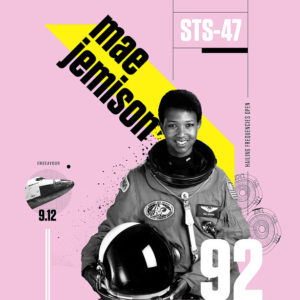March is Women’s History Month, though we can celebrate women in STEM every month! As part of the library collection, we have a series of digital images, “Beyond Curie,” created by Amanda Phingbodhipakkiya. The images highlight women in the STEM fields and are licensed by Creative Commons, meaning anyone in the SMCM community can use these images for non-commercial purposes as long as they give credit. Be sure to give credit–it’s important in all fields but especially in STEM! (Looking at you, Watson and Crick!)
Check out a few highlights from the collection below to learn more about some of the accomplishments of women in STEM. The women featured in this post are pioneers who made discoveries both in and outside of Earth’s atmosphere, from the deep sea to outer space.
Mae Jemison (1956 – )

Image by Amanda Phingbodhipakkiya CC BY-NC-SA
In 1992, Dr. Jemison became the first African-American woman in space. While working as a general practitioner in California, Jemison took graduate classes in engineering and was accepted into NASA’s astronaut program. Let’s pause on that: she was a doctor who just happened to have the hobbies of engineering and being an astronaut (for reference, my hobby is making sticker collages that look like cats). Jemison was the science mission specialist on the space shuttle Endeavour, conducting experiments in the life and material sciences. After returning to Earth, she founded a private research company to implement technology in the developing world. She currently leads the 100 Year Starship project and has her own Lego minifigure.
Mary Golda Ross (1908 – 2008)
In the early years of space exploration, Ross was a pioneer in a new field and as a Native American woman in mathematical and scientific pursuits. After teaching math and science in rural Oklahoma, Ross found work with the Bureau of Indian Affairs in Washington, D.C. She returned to school, earning her Master’s degree in mathematics, and soon after began working with Lockheed to develop fighter planes and missile systems. As the space race took off, Ross focused on hydrodynamics and the launch of the Agena rocket, a turning point for U.S. space endeavors. After retiring, Ross became an advocate for math and engineering education for Native Americans and women.
Sylvia Earle (1935 – )

Image by Amanda Phingbodhipakkiya CC BY-NC-SA
Dr. Earle is an oceanographer and environmentalist who led the first aquanaut team composed of women. Initially blocked from participation in the diving expedition Tektite I because she was a woman, Earle went on to lead the Tektite II Project: part ecological study, and part data gathering on the effects of the deep sea environment on its human participants. In 1979, Earle walked untethered on the seafloor at the depth of 1,250 feet, a record that remains unbroken. Earle has written and published prolifically to share her research and raise awareness of ocean conservation issues, and continues to advocate for the preservation and protection of the marine world.
Sources for more information:
